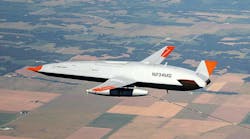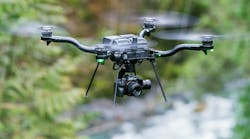Boeing NCO experiment spotlights technologies in urban scenario
A joint urban-warfare demonstration of command and control on the move provided the blueprint for this year’s Boeing joint network-centric operations experiment. The one-hour demonstration at Boeing Phantom Works and Boeing Integrated Defense Systems, linked nine Boeing sites and mixed live and simulated platforms and systems from 17 programs. The purpose was to show how “connecting everyone on the battlefield in a networked operational environment results in people making better decisions faster,” says Gary Fitzmire, Boeing Phantom Works vice president of engineering and information technology. “We’re looking to show three things: a common picture of the battlefield, speed of command, and the use of assets to the best of our ability.” During the scenario, U.S. and coalition forces used network-enabled technologies to eliminate a surface-to-air missile site and a hostile convoy, conduct a multi-lingual interrogation and translation at a security check point, as well as watch and eventually destroy an escaping high-value target.
Barco forms new U.S. company to meet government and military needs
Barco announced that it has established a wholly owned U.S. company named Barco Federal Systems (BFS) Corp. in Duluth, Ga., where Barco has a research and development, manufacturing, and service facility. “The corporate infrastructure to support the new company is being developed in cooperation with the U.S. Department of Security Services,” says Dave Scott, president of Barco North America. BFS will have a U.S.-based board of directors and management team, with autonomous control and influence over BFS. Barco expects the U.S. operation to be operational by March. Development of the company infrastructure has already begun and the existing Barco facility in Duluth will be modified to create a separate, controlled access area for BFS. Barco, an international company headquartered in Kortrijk, Belgium, provides visualization and display solutions. For more information go online at www.barco.com.
Northrop Grumman to enhance video teleconferencing
The Defense Information Systems Agency (DISA) has selected Northrop Grumman Mission Systems in Falls Church, Va., to design, engineer, test, and install new video-teleconferencing hubs for networks supporting Department of Defense missions and operations worldwide. Secure video teleconferencing is a critical command-and-control tool for military commanders. The DISA Defense Information Technology Contracting Organization awarded the Defense Information Systems Network Video Services II (DVS II) task order under Encore I, which is a seven-year, indefinite delivery/indefinite quantity contract awarded by DISA in 2002. Under the task order, Northrop Grumman’s Mission Systems sector is upgrading DISA’s integrated services digital network system with Internet protocol (IP)-based capabilities. The new integrated and secure net-centric system will provide real-time video and audio-conferencing services to DISA and users of the global information grid-bandwidth expansion network, company officials say. Work will be performed in Falls Church, Va., and elsewhere.
NOAA uses unmanned aircraft for research
The National Oceanic and Atmospheric Administration (NOAA) completed its first series of missions using a high-altitude, long-endurance unmanned aircraft system (UAS) to support NOAA’s operational and research needs. Over the course of one flight, the General Atomics Aeronautical Systems Altair UAS set several records, including the longest duration it has flown, the farthest distance from takeoff to return to the same base, and the farthest total distance. The flights demonstrated the Altair’s ability to carry an integrated sensor package as high as approximately 45,000 feet altitude for an extended period. The missions, done with the NASA Dryden Flight Research Center at Edwards Air Force Base, Calif., covered scientific topics from atmospheric chemistry to biological census and coastal mapping. The first flights began in April 2005 and the final missions wrapped up in November. All flights began and ended at Gray Butte Airfield, one of two General Atomics Aeronautical Systems flight operations facilities in California’s Mojave Desert.
Wake County uses new 4.9 GHz public safety band
Public safety officials in Wake County, N.C., deployed Motorola’s MOTOMESH multi-radio broadband solution to enhance public safety measures at three major venues across the county, including the North Carolina State Fairgrounds, Carter-Finley Stadium at North Carolina State University, and the Royal Bank of Canada (RBC) Center. Motorola’s MOTOMESH-based video system sends live video surveillance from major venues to the county public safety headquarters, and to patrolling police officers. The county is the first to complete deployment of a 4.9-GHz MOTOMESH network. The new band offers added security and is less prone to interference than other wireless systems. Wake County used U.S. Deparment of Homeland Security money through its Domestic Preparedness Task Force to purchase the network. For more information see www.motorola.com.


